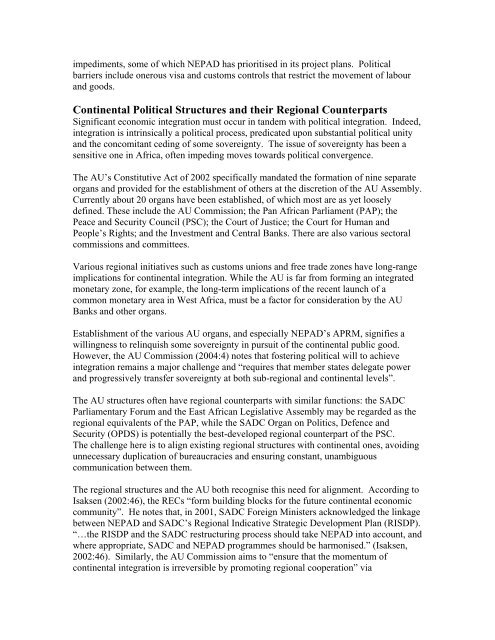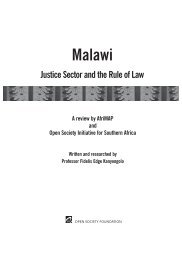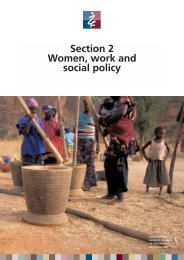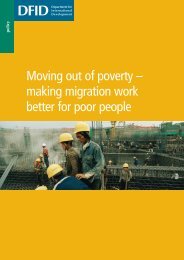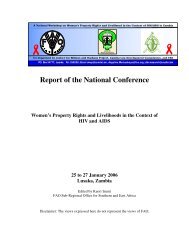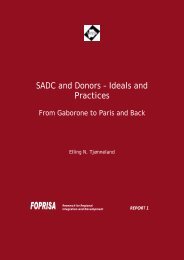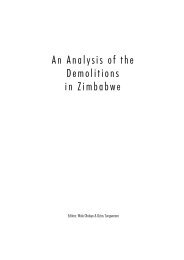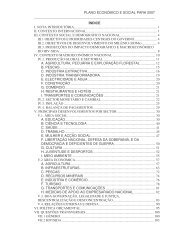The African Union Organs and the African Peer Review ... - SARPN
The African Union Organs and the African Peer Review ... - SARPN
The African Union Organs and the African Peer Review ... - SARPN
You also want an ePaper? Increase the reach of your titles
YUMPU automatically turns print PDFs into web optimized ePapers that Google loves.
impediments, some of which NEPAD has prioritised in its project plans. Politicalbarriers include onerous visa <strong>and</strong> customs controls that restrict <strong>the</strong> movement of labour<strong>and</strong> goods.Continental Political Structures <strong>and</strong> <strong>the</strong>ir Regional CounterpartsSignificant economic integration must occur in t<strong>and</strong>em with political integration. Indeed,integration is intrinsically a political process, predicated upon substantial political unity<strong>and</strong> <strong>the</strong> concomitant ceding of some sovereignty. <strong>The</strong> issue of sovereignty has been asensitive one in Africa, often impeding moves towards political convergence.<strong>The</strong> AU’s Constitutive Act of 2002 specifically m<strong>and</strong>ated <strong>the</strong> formation of nine separateorgans <strong>and</strong> provided for <strong>the</strong> establishment of o<strong>the</strong>rs at <strong>the</strong> discretion of <strong>the</strong> AU Assembly.Currently about 20 organs have been established, of which most are as yet looselydefined. <strong>The</strong>se include <strong>the</strong> AU Commission; <strong>the</strong> Pan <strong>African</strong> Parliament (PAP); <strong>the</strong>Peace <strong>and</strong> Security Council (PSC); <strong>the</strong> Court of Justice; <strong>the</strong> Court for Human <strong>and</strong>People’s Rights; <strong>and</strong> <strong>the</strong> Investment <strong>and</strong> Central Banks. <strong>The</strong>re are also various sectoralcommissions <strong>and</strong> committees.Various regional initiatives such as customs unions <strong>and</strong> free trade zones have long-rangeimplications for continental integration. While <strong>the</strong> AU is far from forming an integratedmonetary zone, for example, <strong>the</strong> long-term implications of <strong>the</strong> recent launch of acommon monetary area in West Africa, must be a factor for consideration by <strong>the</strong> AUBanks <strong>and</strong> o<strong>the</strong>r organs.Establishment of <strong>the</strong> various AU organs, <strong>and</strong> especially NEPAD’s APRM, signifies awillingness to relinquish some sovereignty in pursuit of <strong>the</strong> continental public good.However, <strong>the</strong> AU Commission (2004:4) notes that fostering political will to achieveintegration remains a major challenge <strong>and</strong> “requires that member states delegate power<strong>and</strong> progressively transfer sovereignty at both sub-regional <strong>and</strong> continental levels”.<strong>The</strong> AU structures often have regional counterparts with similar functions: <strong>the</strong> SADCParliamentary Forum <strong>and</strong> <strong>the</strong> East <strong>African</strong> Legislative Assembly may be regarded as <strong>the</strong>regional equivalents of <strong>the</strong> PAP, while <strong>the</strong> SADC Organ on Politics, Defence <strong>and</strong>Security (OPDS) is potentially <strong>the</strong> best-developed regional counterpart of <strong>the</strong> PSC.<strong>The</strong> challenge here is to align existing regional structures with continental ones, avoidingunnecessary duplication of bureaucracies <strong>and</strong> ensuring constant, unambiguouscommunication between <strong>the</strong>m.<strong>The</strong> regional structures <strong>and</strong> <strong>the</strong> AU both recognise this need for alignment. According toIsaksen (2002:46), <strong>the</strong> RECs “form building blocks for <strong>the</strong> future continental economiccommunity”. He notes that, in 2001, SADC Foreign Ministers acknowledged <strong>the</strong> linkagebetween NEPAD <strong>and</strong> SADC’s Regional Indicative Strategic Development Plan (RISDP).“…<strong>the</strong> RISDP <strong>and</strong> <strong>the</strong> SADC restructuring process should take NEPAD into account, <strong>and</strong>where appropriate, SADC <strong>and</strong> NEPAD programmes should be harmonised.” (Isaksen,2002:46). Similarly, <strong>the</strong> AU Commission aims to “ensure that <strong>the</strong> momentum ofcontinental integration is irreversible by promoting regional cooperation” via


